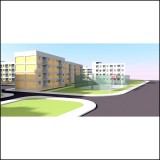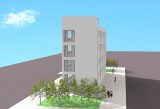Supervisors:
2013
The present diploma project has to do with the labour housing of Xirokambos in Nea Ionia, Volos. The compound was completed in the 1970s by the Ministry of Welfare and covers a surface of 26,300 m2, while each of the buildings covers a surface of 320 m2. Today it is a quite degraded area, in the north-eastern part of the town. The buildings are characterized by the corrosion of materials and inappropriate additions by the inhabitants. The apartments are small, with variable internal temperature, while the pattern of the buildings in the area and the insufficient lighting makes the compound quite dangerous.
An effort is made to intervene in order to enable an architectural, energy and urban upgrade. The most north-eastern block is chosen, due to the fact that it is the most exposed to the harsh climate conditions. Therefore, we try to upgrade the façades of the buildings by adding erkers and balconies. The apartments of each floor are now 4 instead of 6. Glass partitions are added to the exterior of the stairwells, which are framed by shutters. The stairwells end up on the rooftop where they join and make a sheltered communal space. Therooftopbecomesgreenduetotheplanting. Elements of the old façade of the buildings remain, because the main purpose is to preserve parts of the buildings as they are nowadays.
A mini community center is added to the compound and includes a great deal of functions: a kindergarten, a library, a cultural multicenter and a café. The transformations in this building should be more intense. It has to be distinctive because of its functions and at the same time keep elements of the old building.
In parallel with the architectural transformations, we study the bioclimatic handling of the buildings. According to the plans and the orientation, the environmental elements of the area are under survey and so the building is getting more renewed and padded with new materials that maintain the internal thermal comfort, reduce the losses and make it even better for residence.
Eventually, we make an effort to transform the urban pattern, a transformation that will lead to a safer area. As for that, new planted spaces, pedestrian areas, lighting, spaces for public activities as well as parking lots both on the surface of the road and underground to cover the needs of each building, are planned to take place in the area of the compound.
Let us note that all the transformations are made with absolute respect to the building and its environment and according to the needs that were presented by the inhabitants.







